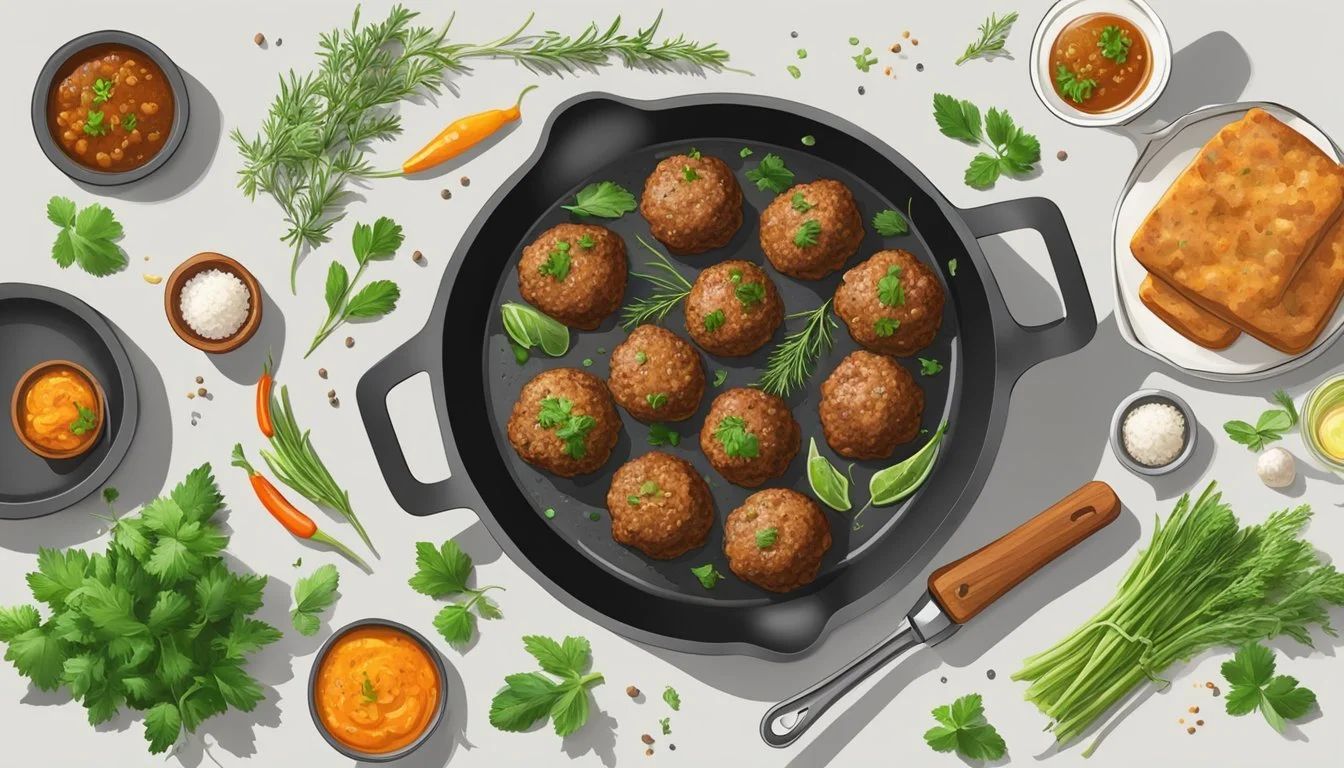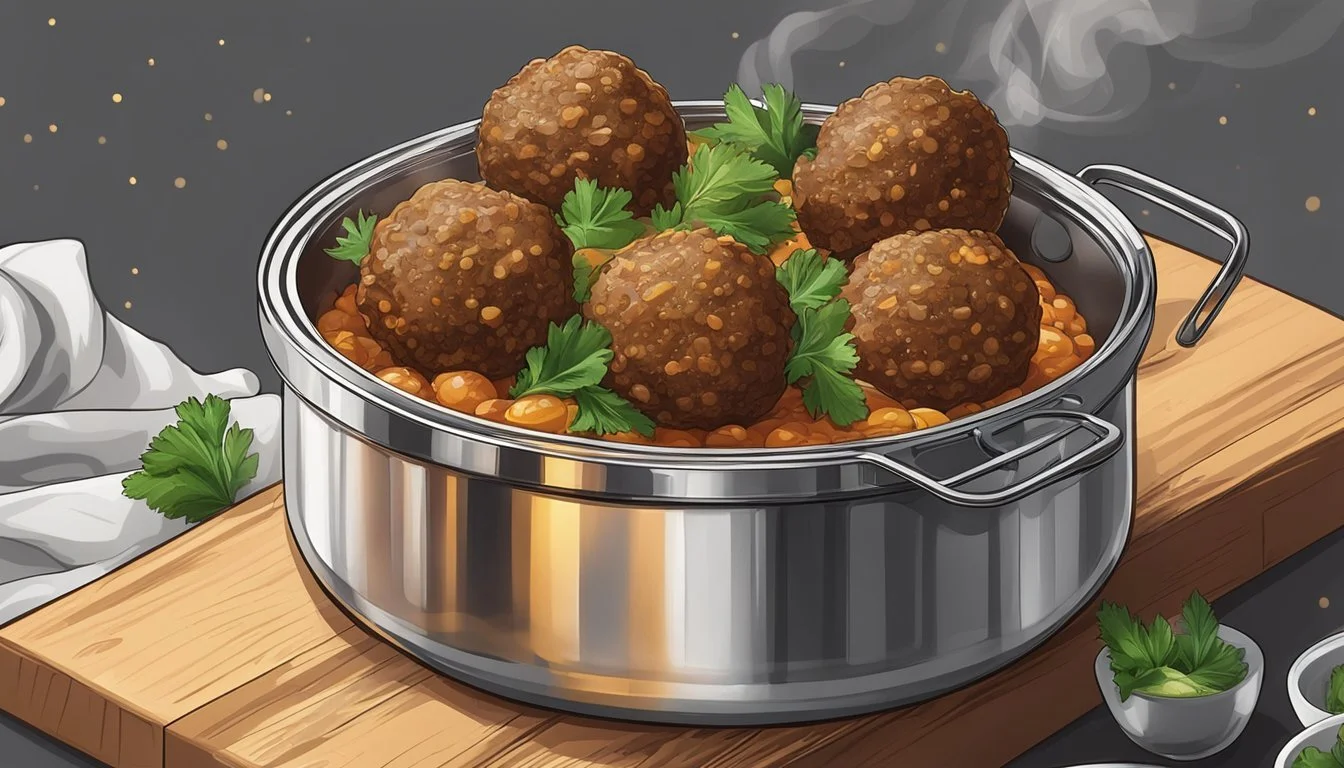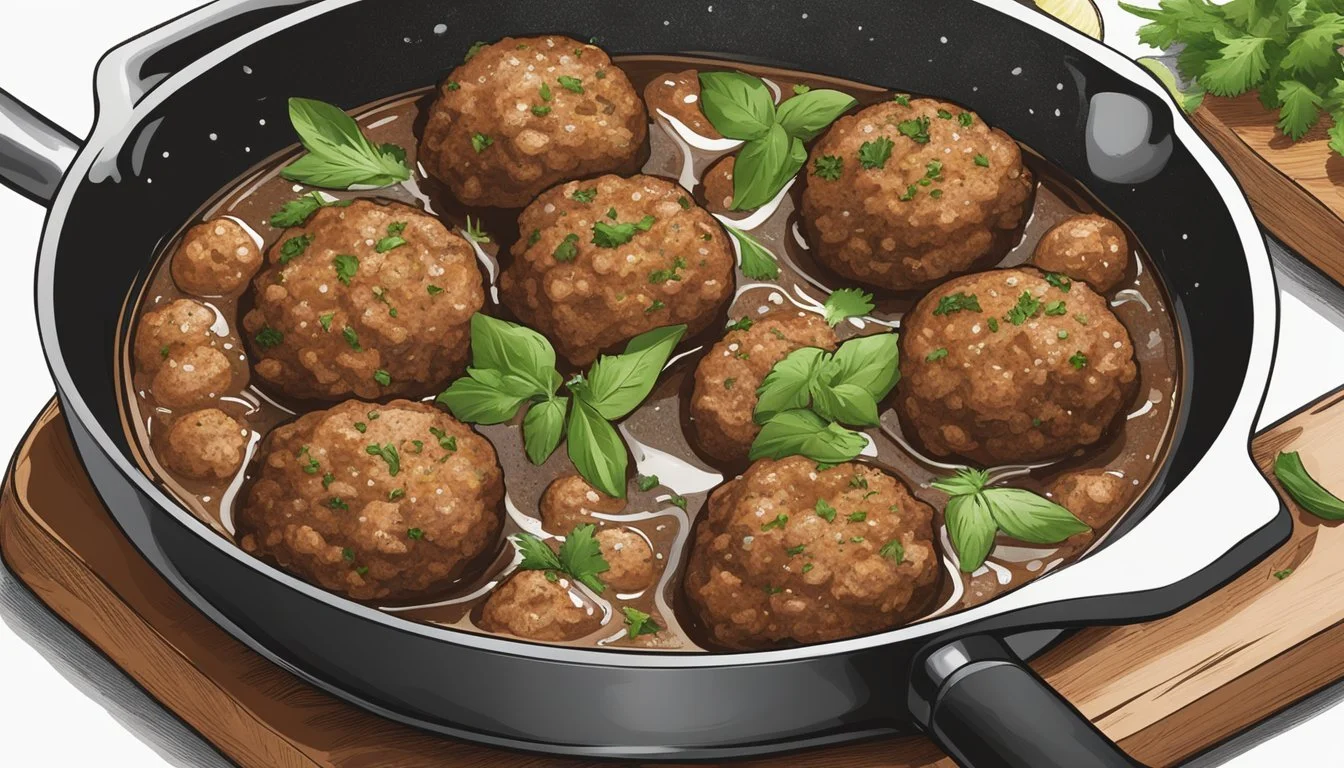Best Way to Reheat Lamb Kofta Meatballs
Ensuring Moistness and Tenderness
Lamb kofta meatballs are a delectable dish that, when cooked right, boast a perfect blend of spices, tenderness, and juiciness. The challenge often comes when it's time to reheat leftovers without compromising their moisture and texture. Maintaining the meatballs' tenderness and moisture during reheating is crucial to preserving their flavor and enjoying the meal as if it were freshly made.
Reheating lamb kofta meatballs effectively requires gentle heat and a method that reincorporates moisture to avoid drying them out. An oven set to a low temperature can be an ideal environment. Covering the meatballs with foil can create a steamy atmosphere, gently warming them through without losing their succulence. For those who favor the stovetop, simmering the meatballs in a savory liquid, such as stock or gravy, can enhance their tenderness while also keeping them moist.
Each reheating method aims to ensure the lamb kofta meatballs retain the succulence and tender texture that make them so appetizing. Whether it’s an oven or stovetop technique, the key is a balance of heat and moisture, leading to a result that should mirror the delightful experience of the initial serving.
Understanding Meatball Basics
In the journey of reheating lamb kofta meatballs to maintain their moisture and tenderness, it is essential to grasp the fundamentals of meatball composition and the impact of cooking and storage methods on their final quality.
Meatball Composition
Meatballs are a culinary staple in many cuisines, essentially composed of ground meat which can include lamb, beef, turkey, pork, or chicken. The flavor profile is enhanced with the inclusion of aromatics such as onion and garlic, as well as a mix of spices like cumin, coriander, paprika, and cinnamon. Parsley adds a fresh touch, while breadcrumbs or panko provide structure. Salt and black pepper are fundamental seasoning agents, often accompanied by kosher salt for flavor.
Cooking Techniques
Meatballs can be cooked using a variety of techniques. An oven is used for baking on a baking sheet, ensuring an even cook. Other methods include grilling for a smoky flavor, or pan-frying on a stove or stovetop for a crispy exterior. Cooking times vary with the method used; however, retaining juices for succulence is key.
The Freezing Process
Meatballs can be frozen both cooked and uncooked. Freezing raw meatballs requires placing them on a baking sheet in the freezer and then transferring to a sealed container once firm. Cooked meatballs are best frozen in gravy or sauce to prevent drying out. They can remain safe and retain quality in the freezer for up to 4 months.
Nutritional Information
Lamb kofta meatballs, like any comfort food, need to be appreciated within the scope of a balanced diet. They are a source of protein, with nutritional content including calories, saturated fat, cholesterol, and varying levels of sodium, potassium, fiber, and sugar. Vitamins such as vitamin C, calcium, iron, and vitamin A are also present, the amounts of which depend on the specific ingredients and recipes used.
Preparations Before Reheating
Proper preparations ensure that lamb kofta meatballs retain their moisture and tenderness during reheating. One must adhere to specific thawing techniques and safety measures to minimize the risk of bacterial growth and ensure the lamb is heated evenly.
Proper Thawing Techniques
If the lamb kofta meatballs are frozen, one should thaw them safely to maintain their quality and texture. For refrigerated meatballs, ensure they are at a uniform temperature before reheating.
Refrigerator Thawing: Transfer meatballs from the freezer to the refrigerator and allow them to thaw gradually over several hours or overnight. It is the safest method to minimize bacterial growth.
Cold Water Thawing: Place the frozen meatballs in a leak-proof plastic bag and submerge them in cold water. Change the water every 30 minutes to maintain a cold environment. Once thawed, reheat the meatballs promptly.
Safety Measures
Safety is paramount to prevent foodborne illnesses. The meatballs must reach a safe internal temperature during reheating to eliminate any harmful bacteria.
Temperature Check: Use a food thermometer to ensure the meatballs have reached a safe internal temperature of 165°F (74°C) after reheating.
Equipment: Verify that all equipment, such as microwaves, ovens, or stovetops, is clean and functioning correctly.
Discarding Rules: It is crucial to discard any meatballs that have been in the danger zone—between 40°F and 140°F—for more than 2 hours, as bacteria can multiply rapidly at these temperatures.
By following these preparation steps, one will have lamb kofta meatballs that are not only safe to eat but also moist and tender.
Reheating Methodologies
To ensure that lamb kofta meatballs retain their moisture and tenderness, they can be reheated using several effective methods. Each method requires careful attention to temperature and technique to maintain quality.
Oven Reheating
For oven reheating, preheat the oven to 300°F. Arrange meatballs in a single layer on a baking dish and cover them with foil to lock in moisture. The meatballs should be heated until warm throughout, typically taking about 15 to 25 minutes depending on their size.
Stovetop Techniques
Using the stovetop, place meatballs in a pan with a splash of stock or gravy to add moisture. Cover and simmer on low heat, allowing the liquid to gently warm and reheat the meatballs, without drying them out, for about 10 to 15 minutes.
Microwave Warming
Microwave warming is the quickest method. To avoid drying out the meatballs, place them in a microwave-safe dish, add a little gravy or sauce, and cover with a lid or microwave-safe plastic wrap. Heat on medium power in short intervals, stirring occasionally to promote even reheating.
Grill Revitalizing
Meatballs can be reheated on a grill. Wrap them in foil with a little bit of added moisture like stock or water, and place them on a grill over low heat. Turn the foil packet occasionally for uniform heating and to keep the meatballs moist, reheating them for around 10 minutes.
Ensuring Moisture and Tenderness
When reheating lamb kofta meatballs, maintaining their inherent moisture and tenderness is crucial. A dry or tough texture can compromise the enjoyment of the dish. The following strategies ensure that reheated meatballs remain just as succulent as when they were first cooked.
Moisture Retention Tactics
Use of Foil: Wrapping the meatballs in foil during the reheating process can help to lock in moisture. The foil acts as a barrier, trapping steam and preventing the meatballs from drying out.
Incorporation of Water or Sauce: Adding a small amount of water or sauce to the meatballs before reheating can provide additional moisture. This helps to create steam within the covered cooking environment, which aids in keeping the meatballs moist.
Avoiding Overcooking
Temperature Control: Set the oven to a moderate temperature, around 300°F (150°C), when reheating lamb kofta meatballs. High heat can cause the proteins to contract too quickly, squeezing out moisture and resulting in a dry texture.
Monitoring Cook Time: Keep a close eye on the meatballs as they reheat. They typically require a cook time of about 15-25 minutes, depending on their size and whether they are thawed or frozen. Overcooking is a common cause of dryness, so it is important to heat the meatballs just until they are warmed through.
Accompaniments and Variations
When serving lamb kofta meatballs, the accompaniments can either complement the flavors or offer a pleasant contrast that enhances the dining experience. Both sides and dips, as well as alternative recipes for meatballs, offer a range of options that suit various tastes and dietary preferences.
Sides and Dips
Sides: A variety of sides can accompany lamb kofta meatballs to complete the meal:
Rice: A staple in Middle Eastern cuisine, rice works well with the rich flavors of lamb kofta, offering a subtle, comforting base.
Salads: From tabbouleh to simple mixed greens, salads add a fresh and crisp texture.
Flatbreads and Pita: Essential for scooping, pita bread and other flatbreads provide a traditional touch to the meal.
Couscous: Couscous, especially when mixed with chopped herbs and nuts, complements the meatballs with its light and fluffy texture.
Dips: Dips can add moisture and an extra dimension of flavor:
Tzatziki: This Greek yogurt-based sauce with cucumber and garlic provides a cool contrast to the spiced kofta.
Hummus: Rich and creamy, hummus pairs well with both the meatballs and accompanying breads.
Alternative Meatball Recipes
Lamb kofta meatballs are versatile and open to experimentation with different meats and seasonings. Here are alternative takes on the classic recipe:
Different Meats: Lamb can be substituted with other meats, such as beef, turkey, or chicken, adjusted for a milder or more robust flavor profile.
Middle Eastern Spices: For those looking to stick to lamb but change the flavor, playing with Middle Eastern spices like cumin, coriander, and sumac can offer new dimensions.
By considering these varied sides, dips, and recipe variations, one can tailor the meal to personal tastes or dietary needs while ensuring the lamb kofta meatballs remain the star of the show.
Storing Leftovers
Proper storage of leftover lamb kofta meatballs is crucial to maintain their moisture and tenderness. It ensures that the meatballs retain their quality whether being refrigerated for short-term use or frozen for extended periods.
Refreezing After Reheating
One should avoid refreezing lamb kofta meatballs that have already been reheated. Each cycle of freezing and thawing can degrade the meatballs’ texture and flavor. If the meatballs have been reheated, it's best to consume them within that same period and not refreeze them.
Refrigeration Best Practices
When storing leftovers in the refrigerator:
Temperature: Ensure your refrigerator is set below 40°F (4°C) to safely store your meatballs.
Airtight containers: Use airtight containers to protect the meatballs from exposure to air, which can dry them out.
Separation: If the meatballs are in sauce, consider storing them separately to avoid them becoming soggy.
When refrigerated promptly and under the right conditions, leftover lamb kofta meatballs can be enjoyed for 2-3 days. Always store the meatballs in a single layer to cool evenly and cover with a piece of baking paper or foil before sealing the container to prevent them from drying out. If stock is available, drizzle a small amount over the meatballs before sealing to help retain moisture.
Conclusion
Reheating lamb kofta meatballs requires a method that maintains their moisture and tenderness. To achieve the best results, one should gently reheat the meatballs, whether they are with or without sauce. For meatballs in sauce, a low oven temperature of 300°F is recommended. This should be done in a covered dish to retain moisture, with occasional stirring to ensure even heating.
When reheating meatballs without sauce, they should be spaced out on a baking tray and covered with foil. The oven should be set to a similar low temperature of 300°F, and care should be taken not to overheat, as this can dry them out. A splash of water can be added to the tray to introduce some steam and further assist in keeping the meatballs moist.
It's also beneficial to consider the number of servings being reheated. Smaller quantities may require less time, whereas larger batches will naturally take longer.
In cases where the lamb kofta meatballs need to be kept warm for extended periods, such as at a gathering, a slow-cooker on a 'warm' setting can be employed. This ensures that the meatballs remain at a safe temperature for consumption without losing their texture.
By applying these skills and techniques, lamb kofta meatballs can be reheated successfully, ensuring they are as enjoyable as when they were first cooked.





